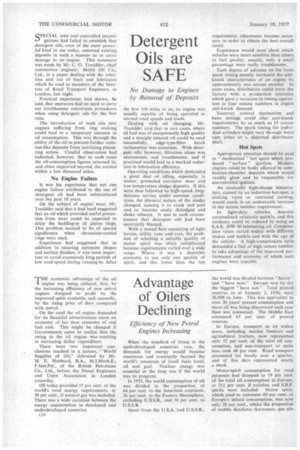Detergent Oils are SAFE
Page 56

If you've noticed an error in this article please click here to report it so we can fix it.
No Damage to Engines by Removal of Deposits
SPECIAL tests and controlled investigations had failed to establish that detergent oils, even of the most power, ful kind in use today, removed existing deposits in such a manner as to cause damage to an :engine. This statement M was made by r. C. G. Tresidder, chief automotive engineer, Mobil Oil Co., Ltd., in a paper dealing with the selection and use of fuels and lubricants which he read to members of the Institute of Road Transport Engineers, in London, last night.
Practical experience had shown, he said, that operators had no need to carry out troublesome conversion procedures when using detergent oils for the first time.
The introduction of such oils into engines suffering from ring sticking could lead to a temporary increase in oil consumption. This was through the ability of the oil to prevent further resinous-like deposits from restricting pistonring action. Careful observation had indicated, however, that in such cases the oil-consumption figures returned to, and often improved beyond, the normal within a few thousand miles.
No Engine Failure
It was his experience that not one engine failure attributed to the use of detergent oil had been substantiated over the past 10 years.
On the subject of engine wear, Mr. Tresidder said that it had beeti suggested that an oil which provided useful protection from wear could be expected to delay the bedding-in of piston rings. This problem seemed to be of special significance when chromium-coated rings were used.
Experience had suggested that in addition to securing optimum shapes and surface finishes, it was inOst import taut to avoid excessively long periods of low road speed during running-in. After
the first 100 miles or so, an engine was usually capable of being operated at normal road speeds and loads.
Dealing with oil changing, Mr. Tresidder said that in rare cases, where oil fuel was of exceptionally high quality and a straight mineral oil could be used successfully, edge-type-filter batch reclamation was economic. With detergent oils, however, filtration alone was uneconomic and troublesome, and if practised would lead to a marked reduction in lubrication efficiency.
Operating conditions which demanded a great deal of idling, especially in winter. promoted corrosive wear and low-temperature sludge deposits. If this were then followed by high-speed, longdistance service under summer conditions, the physical nature of the sludge changed, causing it to crack and peel and to become easily dislodged and choke oilways. It was in such circumstances that detergent oils had been incorrectly blamed.
With a mixed fleet consisting of light lorries, utility vans and cars, the problem of selecting a suitable quality of motor spirit was often complicated because requirements varied over a wide range. Where it was a desirable economy to use only one quality of spirit. and this lower than the top
requirement, adjustment became necessary in order to obtain the best overall result.
Experience would soon show which vehicles were more sensitive than others to fuel quality: usually, only a small percentage were really troublesome.
Each degree of advance on the basic spark timing usually increased the antiknock characteristics of an engine by approximately one octane number in some cases, distributors could leave the factory with a production tolerance which gave a variation in timing equivalent to four octane numbers in engine anti-knock demand.
Incorrect control mechanism and basic settings could alter anti-knock requirements by as much as 15 octane numbers. The spark timing for individual cylinders might vary through worn cam lobes or a distorted distributor shaft.
Hot Spots Appropriate attention should be paid to " mechanical" hot spots which produced " surface " ignition. Modern engines could be badly affected by combustion-chamber deposits which would readily glow and be responsible for uncontrolled ignition.
An unusually high-charge temperature, caused by an induction hot-spot, a sticking valve or restricted cooling, would result in an undesirable increase in the octane number requirement.
In light-duty vehicles, deposits accumulated relatively quickly, and this tendency could be reduced by using an S.A.E. 10W-30 lubricating oil. Compression ratios varied widely with different makes and models and with the age of the vehicle. A high-compression ratio demanded a fuel of high octane number to take advantage of the improved performance and economy of which such engines were capable.








































































































